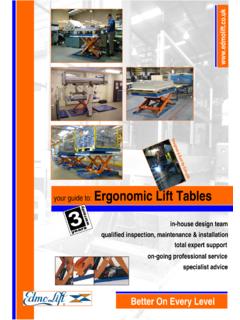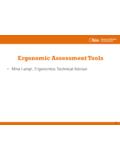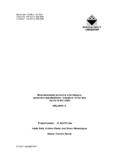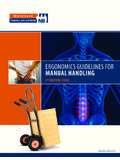Transcription of Ergonomic Guidelines for Manual Material Handling
1 1 Disclaimers Cal/OSHA Consultation Service, Research and Education Unit, Division of Occupational Safety and Health, California Department of Industrial Relations. Ergonomic Guidelines for Manual Material Handling was prepared for publication by the Cal/OSHA Consultation Service, Research and Education Unit, Division of Occupational Safety and Health, California Department of Industrial Relations. It was distributed under the provisions of the Library Distribution Act and Government Code Section 11096. Published 2007 by the California Department of Industrial Relations This booklet is not meant to be a substitute for or a legal interpretation of the occupational safety and health standards. Please see California Code of Regulations, Title 8, or the Labor Code for detailed and exact information, specifications, and exceptions.
2 The mention of any company name or display or use of particular products in this booklet is for illustrative purposes only and does not constitute an endorsement by the Department of Industrial Relations. CNA Insurance Companies Use of the term partnership and/or partner should not be construed to represent a legally binding partnership. The information, examples and suggestions presented in this Material have been developed from sources believed to be reliable, but they should not be construed as legal or other professional advice. CNA accepts no responsibility for the accuracy or completeness of this Material and recommends the consultation with competent legal counsel and/or other professional advisors before applying this Material in any particular factual situations. This Material is for illustrative purposes and is not intended to constitute a contract.
3 Please remember that only a relevant insurance policy can provide actual terms, coverage s, amounts, conditions and exclusions for an insured. All products and services may not be available in all states. CNA is a service mark registered with the United States Patent and Trademark Office. Copyright 2006 CNA. All rights reserved. Material Handling Industry of America (MHIA) These Ergonomic Guidelines are advisory only, having been promulgated with the sole intent of offering information for interested parties. They should be regarded only as a guide that the user may or may not choose to adopt, to modify, or to reject. They do not constitute a comprehensive or complete analysis and should not be relied upon as such. There are no warranties whatsoever that attach to these Guidelines or to any procedures that they may recommend.
4 MHIA specifically DISCLAIMS AND MAKES NO WARRANTIES (EXPRESS OR IMPLIED) OF MERCHANTABILITY OR OF FITNESS FOR A PARTICULAR PURPOSE and MAKES NO WARRANTIES REGARDING THE COMPLETENESS, ACCURACY, RELIABILITY, APPLICABILITY, OR AVAILABILITY OF INFORMATION CONTAINED IN THESE Guidelines . IN NO EVENT SHALL MHIA BE LIABLE FOR ANY DAMAGES, INCLUDING WITHOUT LIMITATION, DIRECT, INDIRECT, SPECIAL, EXEMPLARY OR CONSEQUENTIAL DAMAGES, INCLUDING LOST PROFITS, ARISING UNDER THE USE OF OR RELIANCE ON THESE Ergonomic Guidelines OR THE INFORMATION CONTAINED IN THEM BASED IN CONTRACT, NEGLIGENCE, STRICT LIABILITY OR OTHERWISE, WHETHER OR NOT THEY OR IT HAD ANY KNOWLEDGE, ACTUAL OR CONSTRUCTIVE, THAT SUCH DAMAGES MIGHT BE INCURRED. Further, MHIA shall not be liable in tort, contract, or otherwise, whether based in warranty, negligence, strict liability, or any other theory of liability for any action or failure to act in connection with these recommended Guidelines , it being the user s intent and understanding to absolve and to protect MHIA, its successors and assigns, principals, and employees from any and all liability in tort, contract, or other liability.
5 These Guidelines may contain information provided by third-party parties, and MHIA is not responsible or liable for the truth, accuracy, applicability, or reliability of any such information provided by third parties. National Institute for Occupational Safety and Health (NIOSH) Centers for Disease Control and Prevention Mention of any company name or product does not constitute endorsement by NIOSH/CDC. This document is in the public domain and may be freely copied or reprinted. For information about occupational safety and health topics, contact NIOSH at: 1-800-35-NIOSH (1-800-356-4674) Fax: 513-533-8573 E-mail: National Institute for Occupational Safety and Health Publications Dissemination 4676 Columbia Parkway Cincinnati, OH 45226-1998 DHHS (NIOSH) Publication No. 2007-131 3 Foreword Manual Material Handling (MMH) work contributes to a large percentage of the over half a million cases of musculoskeletal disorders reported annually in the United States.
6 Musculoskeletal disorders often involve strains and sprains to the lower back, shoulders, and upper limbs. They can result in protracted pain, disability, medical treatment, and financial stress for those afflicted with them, and employers often fi nd themselves paying the bill, either directly or through workers compensation insurance, at the same time they must cope with the loss of the full capacity of their workers. Scientific evidence shows that effective Ergonomic interventions can lower the physical demands of MMH work tasks, thereby lowering the incidence and severity of the musculoskeletal injuries they can cause. Their potential for reducing injury-related costs alone make Ergonomic interventions a useful tool for improving a company s productivity, product quality, and overall business competitiveness.
7 But very often productivity gets an additional and solid shot in the arm when managers and workers take a fresh look at how best to use energy, equipment, and exertion to get the job done in the most efficient, effective, and effortless way possible. Planning that applies these principles can result in big wins for all concerned. This booklet will help you to recognize high-risk MMH work tasks and choose effective options for reducing their physical demands. Illustrated inside you will find approaches like: Eliminating lifting from the floor and using simple transport devices like carts or dollies Using lift-assist devices like scissors lift tables or load levelers Using more sophisticated equipment like powered stackers, hoists, cranes, or vacuum assist devices Guiding your choice of equipment by analyzing and redesigning work stations and workflow NIOSH and Cal/OSHA are dedicated to finding the bottom line in state-of the-art-research and turning the results into practical guidance for improving the safety and health of all workers.
8 We hope you find the MMH booklet a useful and effective example of our efforts. John Howard, Len Welsh, , Director, NIOSH Acting Chief, Cal/OSHA Partners The following organizations are responsible for the development and co-publishing of this booklet. To obtain copies of this booklet, contact any of the partners listed below. Cal/OSHA Consultation Service Research and Education Unit 2211 Park Towne Circle, #4 Sacramento, CA 95825 Tel: (916) 574-2528 CNA Insurance Companies 333 S. Wabash Ave. Chicago, IL 60604 Tel: (866) 262-0504 Ergonomic Assist Systems and Equipment (EASE) a Product Council of Material Handling Industry of America (MHIA) 8720 Red Oak Blvd., Suite 201 Charlotte, NC 28217-3992 Tel: (704) 676-1190 National Institute for Occupational Safety and Health (NIOSH) Centers for Disease Control and Prevention 4676 Columbia Parkway Cincinnati, OH 45226-1998 Tel: 1-800-35-NIOSH (1-800-356-4674) 4 Contents About This Booklet 6 Improving Manual Material Handling in Your Workplace 7 What Manual Material Handling Is 8 Why Improve Your Workplace 8 What to Look for 9 Types of Ergonomic Improvements 9 Training 10 A Proactive Action Plan 11 Improvement Options 15 1.
9 Easier Ways to Manually Lift, Lower, Fill, or Empty Containers 17 2. Easier Ways to Manually Carry Containers 29 3. Alternatives to Manual Handling of Individual Containers 35 Resources 49 Appendix A. Administrative Improvements 50 Appendix B. Assessment Tools 52 Appendix C. Analysis Methods 58 Appendix D. Improvement Evaluation Tools 60 Appendix E. Organizations 61 Acknowledgments 65 5 About This Booklet This booklet is written for managers and supervisors in industries that involve the Manual Handling of containers. It offers suggestions to improve the Handling of rectangular, square, and cylindrical containers, sacks, and bags. Improving Manual Material Handling in Your Workplace lists the benefits of improving your work tasks.
10 It also contains information on risk factors, types of Ergonomic improvements, and effective training and sets out a four-step proactive action plan. The plan helps you identify problems, set priorities, make changes, and follow up. Sections 1 and 2 of Improvement Options provide ways to improve lifting, lowering, filling, emptying, or carrying tasks by changing work practices and/or the use of equipment. Guidelines for safer work practices are also included. Section 3 of Improvement Options provides ideas for using equipment instead of manually Handling individual containers. Guidelines for safer equipment use are also included. For more help the Resources section contains additional information on administrative improvements, work assessment tools and comprehensive analysis methods. This section also includes an improvement evaluation tool and a list of professional and trade organizations related to Material Handling .

















